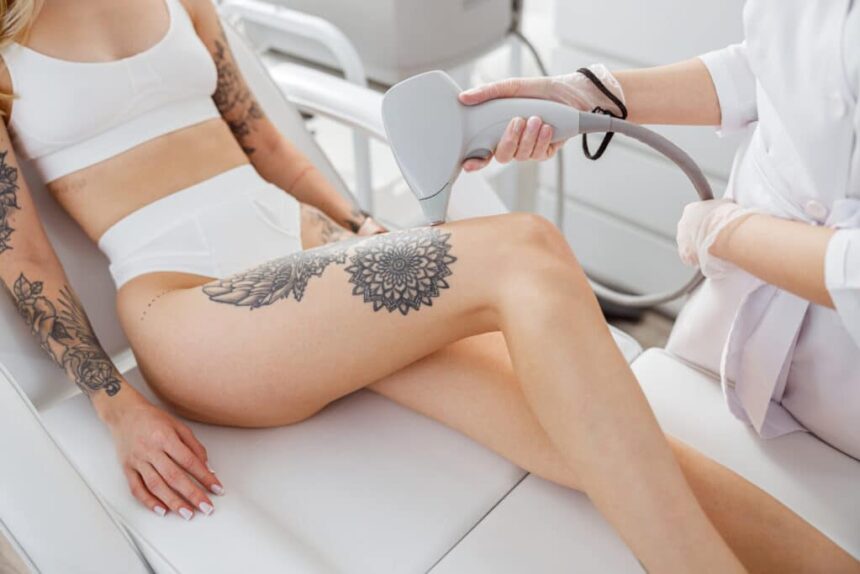Understanding Laser Tattoo Removal
Laser tattoo removal involves the use of high-intensity light beams that break down the ink particles in the skin. Over time, the body’s immune system flushes out these fragmented ink particles, gradually fading the tattoo. Different types of lasers are used depending on the ink color, tattoo depth, and skin type.
For darker skin tones, special care is needed to avoid affecting the natural pigmentation of the skin. Melanin, the pigment responsible for skin color, can absorb laser energy, which may lead to hyperpigmentation (dark spots) or hypopigmentation (light spots) if the wrong laser settings are used.
Choosing the Right Laser for Darker Skin
Selecting the appropriate laser is essential to ensure safe and effective tattoo removal. The most commonly used lasers for darker skin include:
Nd:YAG Laser (1064 nm Wavelength)
- Considered the safest option for darker skin tones.
- Uses a longer wavelength (1064 nm), which penetrates deeper into the skin without affecting melanin.
- Reduces the risk of pigmentation changes while effectively breaking down tattoo ink.
Picosecond Lasers
- Delivers ultra-short pulses to break down ink more efficiently.
- Requires fewer sessions compared to traditional lasers.
- Minimizes heat damage, reducing the risk of skin discoloration.
For multi-colored tattoos, additional wavelengths (such as 532 nm for red ink or 755 nm for green/blue ink) may be needed. However, darker skin tones are more prone to pigmentation changes with shorter wavelengths, so these treatments require careful adjustments by an experienced practitioner.
How the Procedure Works
1. Initial Consultation
A consultation with a laser specialist is crucial before starting the removal process. The practitioner will assess the tattoo, skin type, and medical history to determine the best treatment plan.
2. Pre-Treatment Preparation
- Avoid sun exposure for at least 2-4 weeks before treatment to reduce the risk of pigmentation issues.
- Discontinue the use of skin-lightening creams or active ingredients like retinoids, which may make the skin more sensitive.
- Stay hydrated and maintain healthy skin to promote better healing.
3. Laser Treatment Session
- A numbing cream may be applied to minimize discomfort.
- The laser device is directed at the tattoo, emitting pulses of light that break down the ink.
- Each session lasts between 10 to 30 minutes, depending on the tattoo size and complexity.
- Cooling techniques, such as ice packs or cool air, may be used to soothe the skin.
4. Post-Treatment Care
- Apply an antibiotic ointment to prevent infection.
- Avoid sun exposure and use SPF 50+ sunscreen to protect treated areas.
- Refrain from scratching or picking at the skin to prevent scarring.
- Keep the area clean and moisturized to aid healing.
How Many Sessions Are Needed?
Tattoo removal requires multiple sessions, typically spaced 6-8 weeks apart, to allow the body time to clear the broken-down ink. The number of sessions depends on factors such as:
- Tattoo Color: Black ink is the easiest to remove, while lighter colors may require additional treatments.
- Tattoo Depth and Age: Older tattoos fade faster, while newer or deeper tattoos may take longer.
- Skin Type: Darker skin tones require a cautious approach with lower energy settings to prevent pigmentation changes, which may extend the number of sessions needed.
On average, most people need 6-12 sessions for complete removal, but results vary based on individual factors.
Addressing Potential Risks for Darker Skin
Hyperpigmentation (Dark Spots)
Some individuals may experience darkened skin in the treated area. This is usually temporary and fades over time with proper aftercare.
Hypopigmentation (Light Spots)
Lighter patches may appear if too much melanin is affected by the laser. Choosing the right laser and an experienced practitioner helps minimize this risk.
Scarring and Skin Sensitivity
When performed correctly, laser tattoo removal does not leave scars. However, improper aftercare, excessive sun exposure, or scratching the treated area can increase the risk of scarring.
Why Choose Laser Tattoo Removal in Abu Dhabi?
Abu Dhabi offers advanced laser technologies and experienced specialists trained in treating diverse skin types. The city’s high standards in dermatology and aesthetic treatments ensure safe and effective results for individuals with darker skin tones.



